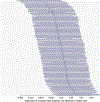Assessing Clinician Utilization of Next-Generation Antibiotics Against Resistant Gram-Negative Infections in U.S. Hospitals : A Retrospective Cohort Study
- PMID: 38639548
- PMCID: PMC12483541
- DOI: 10.7326/M23-2309
Assessing Clinician Utilization of Next-Generation Antibiotics Against Resistant Gram-Negative Infections in U.S. Hospitals : A Retrospective Cohort Study
Abstract
Background: The U.S. antibiotic market failure has threatened future innovation and supply. Understanding when and why clinicians underutilize recently approved gram-negative antibiotics might help prioritize the patient in future antibiotic development and potential market entry rewards.
Objective: To determine use patterns of recently U.S. Food and Drug Administration (FDA)-approved gram-negative antibiotics (ceftazidime-avibactam, ceftolozane-tazobactam, meropenem-vaborbactam, plazomicin, eravacycline, imipenem-relebactam-cilastatin, and cefiderocol) and identify factors associated with their preferential use (over traditional generic agents) in patients with gram-negative infections due to pathogens displaying difficult-to-treat resistance (DTR; that is, resistance to all first-line antibiotics).
Design: Retrospective cohort.
Setting: 619 U.S. hospitals.
Participants: Adult inpatients.
Measurements: Quarterly percentage change in antibiotic use was calculated using weighted linear regression. Machine learning selected candidate variables, and mixed models identified factors associated with new (vs. traditional) antibiotic use in DTR infections.
Results: Between quarter 1 of 2016 and quarter 2 of 2021, ceftolozane-tazobactam (approved 2014) and ceftazidime-avibactam (2015) predominated new antibiotic usage whereas subsequently approved gram-negative antibiotics saw relatively sluggish uptake. Among gram-negative infection hospitalizations, 0.7% (2551 [2631 episodes] of 362 142) displayed DTR pathogens. Patients were treated exclusively using traditional agents in 1091 of 2631 DTR episodes (41.5%), including "reserve" antibiotics such as polymyxins, aminoglycosides, and tigecycline in 865 of 1091 episodes (79.3%). Patients with bacteremia and chronic diseases had greater adjusted probabilities and those with do-not-resuscitate status, acute liver failure, and Acinetobacter baumannii complex and other nonpseudomonal nonfermenter pathogens had lower adjusted probabilities of receiving newer (vs. traditional) antibiotics for DTR infections, respectively. Availability of susceptibility testing for new antibiotics increased probability of usage.
Limitation: Residual confounding.
Conclusion: Despite FDA approval of 7 next-generation gram-negative antibiotics between 2014 and 2019, clinicians still frequently treat resistant gram-negative infections with older, generic antibiotics with suboptimal safety-efficacy profiles. Future antibiotics with innovative mechanisms targeting untapped pathogen niches, widely available susceptibility testing, and evidence demonstrating improved outcomes in resistant infections might enhance utilization.
Primary funding source: U.S. Food and Drug Administration; NIH Intramural Research Program.
Conflict of interest statement
Figures





Comment in
-
New Antibiotics for Resistant Infections: What Happens After Approval?Ann Intern Med. 2024 May;177(5):674-675. doi: 10.7326/M24-0192. Epub 2024 Apr 19. Ann Intern Med. 2024. PMID: 38639541 No abstract available.
References
-
- Biomedical Advanced Research and Development Authority (BARDA). BARDA Support Protects Against Drug-Resistant Threats. BARDA; 27 April 2023. Accessed at https://medicalcountermeasures.gov/stories/amr on 12 June 2023.
Publication types
MeSH terms
Substances
Grants and funding
LinkOut - more resources
Full Text Sources
Medical
